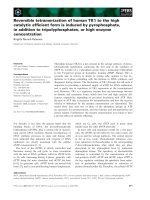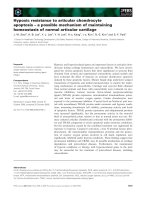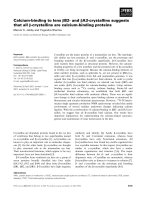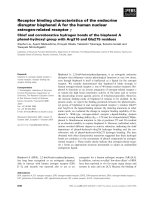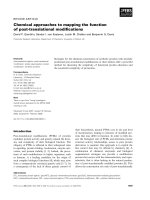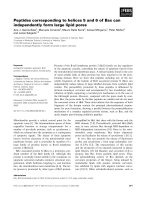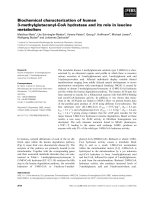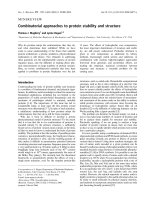Báo cáo khoa học: Nucleotide binding to human UMP-CMP kinase using fluorescent derivatives ) a screening based on affinity for the UMP-CMP binding site potx
Bạn đang xem bản rút gọn của tài liệu. Xem và tải ngay bản đầy đủ của tài liệu tại đây (401.2 KB, 11 trang )
Nucleotide binding to human UMP-CMP kinase using
fluorescent derivatives ) a screening based on affinity
for the UMP-CMP binding site
Dimitri Topalis
1,
*, Hiroki Kumamoto
2,
*, Maria-Fernanda Amaya Velasco
3,
*, Laurence Dugue
´
4
,
Ahmed Haouz
5
, Julie Anne C. Alexandre
1
, Sarah Gallois-Montbrun
6,†
, Pedro Maria Alzari
3
,
Sylvie Pochet
4
, Luigi Andre
´
Agrofoglio
2
and Dominique Deville-Bonne
1
1 Laboratoire d’Enzymologie Mole
´
culaire et Fonctionnelle, FRE 2852 CNRS-Paris 6, Institut Jacques Monod, Paris, France
2 Institut de Chimie Organique et Analytique, UMR CNRS 6005, FR 2708, Universite
´
d’Orle
´
ans, UFR Sciences, Orle
´
ans, France
3 Unite
´
de Biochimie Structurale, URA CNRS 2185, Institut Pasteur, Paris, France
4 Unite
´
de Chimie Organique, URA CNRS 2128, Institut Pasteur, Paris, France
5 Plate-Forme 6- Cristalloge
´
ne
`
se et Diffraction des Rayons X, Institut Pasteur, Paris, France
6 Unite
´
de Re
´
gulation Enzymatique des Activite
´
s Cellulaires, CNRS URA 2185, Institut Pasteur, Paris, France
Human UMP-CMP kinase (UCK) plays a key role in
the ribonucleoside and deoxyribonucleoside salvage
pathway and in the anabolic phosphorylation of nucleo-
side analogs used as antiviral and anticancer agents. The
phosphorylation of nucleoside analogs requires three
steps involving the action of deoxyribonucleoside kinase
Keywords
cidofovir; human UMP-CMP kinase; MABA-
CDP; Mant-ATP; phosphonates
Correspondence
D. Deville-Bonne, Laboratoire d’Enzymologie
Mole
´
culaire et Fonctionnelle, FRE 2852
CNRS-Paris 6, Institut Jacques Monod,
4, place Jussieu, 75251 Paris Cedex 05,
France
Fax: +33 1 44 27 59 94
Tel: +33 1 44 27 59 93,
E-mail:
*These authors contributed equally to this
work
Present address
Department of Infectious Diseases, Guy’s,
King’s and St Thomas’ Medical School,
King’s College London, GKT Guy’s Hospital,
London
(Received 12 February 2007, revised
25 May 2007, accepted 29 May 2007)
doi:10.1111/j.1742-4658.2007.05902.x
Methylanthraniloyl derivatives of ATP and CDP were used in vitro as
fluorescent probes for the donor-binding and acceptor-binding sites of
human UMP-CMP kinase, a nucleoside salvage pathway kinase. Like all
NMP kinases, UMP-CMP kinase binds the phosphodonor, usually ATP,
and the NMP at different binding sites. The reaction results from an in-line
phosphotransfer from the donor to the acceptor. The probe for the donor
site was displaced by the bisubstrate analogs of the Ap5X series (where
X ¼ U, dT, A, G), indicating the broad specificity of the acceptor site.
Both CMP and dCMP were competitors for the acceptor site probe. To
find antimetabolites for antivirus and anticancer therapies, we have devel-
oped a method of screening acyclic phosphonate analogs that is based on
the affinity of the acceptor-binding site of the human UMP-CMP kinase.
Several uracil vinylphosphonate derivatives had affinities for human UMP-
CMP kinase similar to those of dUMP and dCMP and better than that of
cidofovir, an acyclic nucleoside phosphonate with a broad spectrum of
antiviral activities. The uracil derivatives were inhibitors rather than
substrates of human UMP-CMP kinase. Also, the 5-halogen-substituted
analogs inhibited the human TMP kinase less efficiently. The broad speci-
ficity of the enzyme acceptor-binding site is in agreement with a large
substrate-binding pocket, as shown by the 2.1 A
˚
crystal structure.
Abbreviations
Ap5A, P
1
-(5¢-adenosyl) P
5
-(5¢-adenosyl) pentaphosphate; Ap5dT, P
1
-(5¢-adenosyl) P
5
-[5¢-(2¢-deoxy-thymidyl)] pentaphosphate; Ap5G,
P
1
-(5¢-adenosyl) P
5
-(5¢-guanosyl) pentaphosphate; Ap5U, P
1
-(5¢-adenosyl) P
5
-(5¢-uridyl) pentaphosphate; cidofovir, (S)-1-(3-hydroxy-2-
phosphonylmethoxypropyl) cytosine; MABA-CDP, cytidine diphospho-b-(N¢-methylanthraniloylaminobutyl)-phosphoramidate; Mant,
N-methylanthraniloyl; UCK, UMP-CMP kinase; UVP, uracil vinylphosphonate.
3704 FEBS Journal 274 (2007) 3704–3714 ª 2007 The Authors Journal compilation ª 2007 FEBS
[1], NMP kinase [2] and finally NDP kinase [3] and ⁄ or
one of the enzymes capable of synthesizing ATP, such
as phosphoglycerate kinase [4,5], pyruvate kinase or
creatine kinase [6]. However, acyclic nucleoside phos-
phonates, a new class of antiviral analogs [7], do not
require the first phosphorylation step and depend on
cellular NMP kinases or, in some cases, on viral NMP
kinases. Human UCK, also known as pyrimidine nucle-
oside monophosphate kinase [6], is an NMP kinase.
These enzymes all have a highly conserved fold. The
family includes six isoforms of AMP kinase, one TMP
kinase and one GMP kinase. Like most NMP kinases,
human UCK is located in the cytosol, but isoforms 2
and 3 of AMP kinases are found in the mitochondria
and isoform 6 in the nucleus. Another dTMP kinase, as
yet unidentified, may be located in mitochondria [8].
The primary sequence of human UCK is 40% identical
to that of AMP kinase 1, 27% identical to that of AMP
kinase 2, 21% identical to that of dTMP kinase, and
20% identical to that of GMP kinase. The structure of
human UCK has been determined recently, but in the
absence of a ligand [9]. However, the active site of the
homologous enzyme from Dictyostelium complexed with
the bisubstrate inhibitor P
1
-(5¢-adenosyl) P
5
-(5¢-uridyl)
pentaphosphate (Ap5U) is known [10].
The human UCK efficiently phosphorylates the
monophosphorylated forms of arabinocytidine, gemcit-
abine and 3¢thiancytidine, which are used to treat
leukemia, pancreatic cancer and AIDS [11]. In con-
trast, the dCMP acyclic phosphonate mimic, cidofovir
[(S)-1-(3-hydroxyl-2-phosphonomethoxy-propyl) cyto-
sine], which is approved for treating cytomegalovirus
retinitis in patients with AIDS and has more recently
been approved for persons infected with monkeypox
virus, is poorly phosphorylated by human UCK [6].
The bioavailablity of cidofovir is below 5% but its
in vitro activity against herpes and orthopox viruses
can be increased by several orders of magnitude by
esterification with lipidic groups, which improve its
penetration into cells [12]. Cidofovir, like the other
antiviral nucleoside phosphonates, is very stable and
has a long half-life in the body [7]. Among other
licensed antiviral nucleoside phosphonates, the anti-
hepatitis B virus agent, adefovir dipivoxil [9-(2-phos-
phono-methoxylethyl) adenine dipivoxil] and the
anti-human immunodeficiency virus agent tenofovir
disoproxil fumarate (9-[2-(R)-(phosphonomethoxy)
propyl] adenine disoproxil fumarate) [7], once the pro-
tecting groups have been removed, are activated ineffi-
ciently by phosphorylation with cellular AMP kinases
[13,14]. The first phosphorylation of antiviral nucleo-
side phosphonates, catalyzed by NMP kinases, is prob-
ably a bottleneck in their activation. We have looked
for new acyclic phosphonate derivatives that interact
better with NMP kinases and are more readily phos-
phorylated to give active forms. We have studied the
specificity of binding at the acceptor site of human
UCK in order to identify potential ligands among new
acyclic nucleoside phosphonates considered to be cid-
ofovir analogs. We used N-methyl anthraniloyl (Mant)
nucleotides (Mant-ATP [15] and cytidine diphospho-
b-(N¢-methylanthraniloylaminobutyl)-phosphoramidate
(MABA-CDP ) [16]) as fluorescent probes to monitor
the binding of nucleotides to UCK. These assays were
used to determine the binding affinity of bisubstrates
and new phosphonate analogs and to validate a fluor-
escent approach for high-throughput screening of new
compounds.
Results and Discussion
Competitive fluorescence experiments to
determine the binding of natural substrates to
the donor and the acceptor sites of human UCK
The ATP-binding site (‘donor-binding site’) of human
UCK was probed with the fluorescent nucleotide
Mant-ATP, in which the methylanthranylate group is
bound to the 2¢-OH and 3¢-OH of the ribose [15].
Mant-ATP binding to the enzyme resulted in a large
increase in fluorescence intensity (220%). Titration of
Mant-ATP with human UCK fitted the Langmuir
binding equation with a stoichiometry of 1 and an
equilibrium dissociation constant, K
D
, of 3.5 lm
(results not shown). Mant-ATP binding was not modi-
fied by CMP, in contrast to Escherichia coli CMP
kinase [17]. Mant-ATP was displaced by ATP with
a K
ATP
D
¼ 10 lm in a competitive titration and in an
indirect titration assay for several ATP concentrations
(not shown). Other nucleotides such as CTP and ADP
also displaced Mant-ATP. The bisubstrate analog
Ap5U displaced Mant-ATP (K
Ap5U
D
¼ 0.15 lm) better
than ATP (Fig. 1). The other bisubstrate analogs in
which U in Ap5U was replaced by A, G or even dT
were also competitors, although they were less efficient
than Ap5U (Fig. 1). The K
D
value for P
1
-(5¢-adenosyl)
P
5
-[5¢-(2¢-deoxy-thymidyl)] pentaphosphate (Ap5dT)
(3.5 lm) was lower than that for ATP (10 lm), sug-
gesting that the dTDP moiety in Ap5dT contributes to
the binding energy. This is the first evidence that any
base including thymidine can be accommodated in the
NMP acceptor site of human UCK (Fig. 1).
The acceptor-binding site of human UCK was also
probed with the fluorescent nucleotide MABA-CDP,
in which the Mant group is bound to the b-phos-
phate of CDP through a butyl linker (Fig. 2A).
D. Topalis et al. UMP-CMP kinase and acyclic phosphonate analogs
FEBS Journal 274 (2007) 3704–3714 ª 2007 The Authors Journal compilation ª 2007 FEBS 3705
Dictyostelium UCK has been reported to specifically
bind MABA-CDP at the CMP-binding site [16]. Add-
ing human UCK increased the fluorescence of MABA-
CDP, and the spectrum shifted slightly towards blue.
Excess of CMP or CDP returned the fluorescence of
MABA-CDP to its initial value, demonstrating the
specificity of MABA-CDP binding to the acceptor-
binding site (Fig. 3A, inset). Titration of MABA-CDP
with the enzyme (Fig. 3A) indicated an increase in
fluorescence of 160% at saturation and an equilibrium
dissociation constant K
MABAÀCDP
D
¼ (8.5 ± 1.0) lm
when fitted to the Langmuir binding equation. The
fluorescence of the MABA-CDP ⁄ enzyme complex was
decreased by CDP and other nucleotides (Fig. 3A,
inset). The fluorescence of human UCK was unaffected
by ATP, unlike that of UCK from Dictyostelium, indi-
cating that MABA-CDP does not probe the human
UCK ATP site [16]. The concentrations of nucleotide
needed to get half the signal (IC
50
) were determined by
competition experiments (Fig. 3B). The equilibrium
dissociation constants K
D
are summarized in Table 1.
CDP was better at displacing MABA-CDP than CMP,
perhaps because the enzyme ⁄ MABA-CDP conforma-
tion favors the reverse reaction (CDP + ADP fi
CMP + ATP).
CDP, CMP, UMP, dCMP and dUMP all com-
peted with MABA-CDP at the acceptor-binding site,
showing that the same NMP site binds ribonucleo-
sides and deoxyribonucleosides under our experimen-
tal conditions (5 mm magnesium ions). This does not
fit the hypothesis that acceptor sites use either ribo-
nucleoside or deoxyribonucleoside monophosphate
[18]. Cytidine nucleotides had higher affinities than
uridine nucleotides, as reported for the Dictyostelium
enzyme. The comparison between cytidine and uridine
monophosphates in Table 1 is in agreement with the
preference for ribonucleotides rather than deoxyribo-
nucleotides. The 5–6-fold difference in K
D
values was
presumably due to the interaction of the sugar 2¢-OH
group with the carbonyl of Lys61 [9,10]. Both AMP
and also dTMP displaced MABA-CDP from the accep-
tor-binding site with submillimolar K
D
, in agreement
with the results in Fig. 1 for Mant-ATP. The affinity of
the human enzyme acceptor-binding site for NMPs was
5–20 times higher than that of Dictyostelium UCK,
despite identical active site residues [10,16]. The K
D
val-
ues in Table 1 are in agreement with the kinetic param-
eters of the natural nucleoside monophosphates
dCMP, dUMP and AMP [19]. GMP and dTMP were
not substrates of the enzyme, indicating that their bind-
ing to the NMP-binding site is unproductive.
UCK has been identified in human liver as the
enzyme that catalyzes the first phosphorylation step
for cidofovir [6]. The binding of cidofovir was substan-
tially weaker than that of natural substrates. It was
also a poor substrate for recombinant human UCK,
with a low k
cat
(k
cat
¼ 0.06 s
)1
, K
m
¼ 1mm) resulting
in a low catalytic efficiency, about 60 m
–1
Æs
)1
. These
Fig. 1. Fluorescence competition assays with Mant-ATP bound to
the human UCK donor-binding site. Mant-ATP (3 l
M) + human UCK
(10 l
M), resulting in 50% fluorophore bound, was titrated with
Ap5U (d), Ap5A (j), Ap5G (n), Ap5dT (s) and ATP (m) with IC
50
¼
1 l
M, 4.4 lM,11lM,25lM and 50 lM, respectively (k
excitation
¼
350 nm, k
emission
¼ 436 nm, excitation slit ¼ 1 nm, k
emission
slit ¼ 4 nm). The values for the equilibrium constants K
D
calcula-
ted as in Experimental procedures are: 0.15 l
M for Ap5U, 0.7 lM
for Ap5A, 1.7 lM for Ap5G, 3.4 lM for Ap5dT, and 9.5 lM for ATP.
Fig. 2. (A) Formula of MABA-CDP used in
the fluorescent competitive titration assay
to determine dissociation constants of acy-
clic nucleotides. (B) Formula of C5-substi-
tuted vinyl phosphonates (Y ¼ H, Cl, Br,
phenyl, fluorophenyl, phenyl-S).
UMP-CMP kinase and acyclic phosphonate analogs D. Topalis et al.
3706 FEBS Journal 274 (2007) 3704–3714 ª 2007 The Authors Journal compilation ª 2007 FEBS
properties are comparable to those of the human liver
enzyme [6]. The MABA-CDP competition assay gave a
K
D
of 0.3 mm for cidofovir, similar to that of dUMP
(Fig. 3B and Table 1). The ratio between cidofovir and
dCMP binding affinities was no more than 5, a value
similar to the ratio between the CMP and dCMP equi-
librium constants.
Binding of acyclic phosphonate nucleosides
to the acceptor site of human UCK using
fluorescent MABA-CDP
Several uracil vinylphosphonates (UVPs) modified at
the 5-position were produced by parallel synthesis [20]
and evaluated for human UCK activity in order to
find acyclic phosphonate nucleoside analogs possessing
a better affinity for human UCK than cidofovir
(Scheme 1 and Fig. 2B). None of them was a substrate
for human UCK, but they were all inhibitors. Their
binding affinities for human UCK were studied using
both the MABA-CDP fluorescent competition and
activity assays. A preliminary plate-adapted assay indi-
cated that all the molecules except the 5-fluorophenyl
derivative (compound 6e) competed with MABA-CDP
(1 mm). The IC
50
values were measured individually by
fluorometric competition titration, and the dissociation
constants (K
D
) were calculated (Table 2). The displace-
ment was total for all compounds except for com-
pound 6d (5-Phe-UVP) (50%), which was not suitable
for the assay, due to its poor solubility. The IC
50
val-
ues were also evaluated with the human UCK activity
assay under standard conditions, i.e. 50 lm CMP and
0.5 mm ATP (Table 2). Both assays usually gave IC
50
values in the same range. The values for compound 6a
(UVP) are less accurate, probably due to the poor
Fig. 3. Fluorescence assays with MABA-CDP bound to the human UCK acceptor site. (A) Dissociation equilibrium constant of MABA-CDP ⁄
enzyme complex determined by the fluorescence assay. The fluorescent signal of MABA-CDP (2 l
M) was monitored after stepwise addition
of human UCK (k
excitation
¼ 325 nm, k
emission
¼ 430 nm, excitation slit ¼ 2 nm, emission slit ¼ 2 nm). The signal was fitted to the Langmuir
binding equation with a fixed maximum enhancement of fluorescence of 160%. The K
D
was 8.5 ± 1.5 lM. Inset: Fluorescence emission
spectra of MABA-CDP (10 l
M) in T buffer (k
excitation
¼ 325 nm, excitation slit ¼ 2 nm, emission slit ¼ 2 nm). (a) MABA-CDP alone. (b)
MABA-CDP + 50 l
M human UCK. (c) MABA-CDP + 50 lM human UCK + 5 mM CDP or CMP. (B) Fluorescence competition assays with
MABA-CDP bound to the human UCK acceptor-binding site. MABA-CDP (8 l
M) + human UCK (24 lM) titrated with CMP (d), dCMP (s),
UMP (j), AMP (·) TMP (h) and cidofovir (m).
Table 1. Equilibrium dissociation constants and kinetic parameters
of human UCK for natural NMP and cidofovir. The K
D
values were
obtained from fluorescence competition assays with MABA-CDP
bound to the human UCK acceptor-binding site. The conditions are
shown in Fig. 3B. The kinetic constants were measured under
standard conditions in the presence of 1 m
M ATP and 5 mM Mg
2+
.
ND, not detectable.
Ligand K
D
(lM) ⁄ MABA-CDP K
m
(mM) k
cat
(s
)1
)
k
cat
⁄ K
m
(M
)1
Æs
)1
)
CDP 6 ± 1 –
CMP 10 ± 2 0.07
a
130
a
10
6a
dCMP 60 ± 10 1.1
a
75
a
3 · 10
4a
UMP 90 ± 10 0.13
a
130
a
6 · 10
5a
dUMP 400 ± 50 1.3 ± 0.3 8 ± 1 6 · 10
3
dTMP 750 ± 150 ND ND ND
Cidofovir 300 ± 100 1.0 ± 0.3 0.06 ± 0.02 60
AMP 100 ± 30 > 5
a
ND 10
3a
GMP 500 ± 100 ND ND ND
a
Data from Pasti et al. [19].
D. Topalis et al. UMP-CMP kinase and acyclic phosphonate analogs
FEBS Journal 274 (2007) 3704–3714 ª 2007 The Authors Journal compilation ª 2007 FEBS 3707
affinity of the enzyme for this compound. The 6e
derivative (5-F-Phe-UVP) was only detected in the
enzymatic assay, indicating that the inhibition may
involve binding to a site different from the CMP-bind-
ing site. Cidofovir binding was detected only in the
MABA-CDP competition assay, a fact that was expec-
ted, as the enzymatic assay did not detect inhibition by
substrates.
Kinetic studies were also performed with 0.5 mm
ATP and dCMP as acceptor substrate. Several vinyl-
phosphonates were clearly competitive inhibitors of
dCMP [Fig. 4 for the 6c derivative (5-Cl-UVP) (K
i
¼
16±3lm]. The dissociation constant for 5-Br-vinyl-
phosphonate (compound 6b) was in the same range as
that for 5-Cl-UVP (compound 6c) and about 17 times
smaller than that for cidofovir. The halogen substitu-
tion in the 5-position (Br, Cl) improved binding: UVP
(compound 6a) inhibited the enzyme (K
i
¼ 0.7 mm) less
well (Table 2). No clear binding was detected when the
5-halogen was replaced by a larger group such as Phe,
Scheme 1. Synthesis of novel acyclic phosphononucleoside analogs. Reagents: (a) (i) benzenethiol (PhSH), N-chlorosuccinimide (NCS), pyrid-
ine, MeCN, reflux; (ii) crotyl bromide, K
2
CO
3
, dimethylformamide; (iii) K
2
CO
3
, MeOH; (b) Bu
3
SnH, AIBN, toluene, reflux; (c) N-bromosuccini-
mide (NBS) (or NCS), tetrahydrofan (THF) (for 4b and 4c, respectively) or aryliodide (RI), PdCl
2
(PPh
3
)
2
(0.11 mmol), CuI, dimethylformamide,
rt (for 4d–f); (d) diethyl vinyl phosphonate (4 eq.), Nolan’s catalyst ¼,CH
2
Cl
2
, reflux; (e) TMSBr (4 eq.), CH
2
Cl
2
.
Table 2. Binding affinities of human UCK for new uracil acyclic
phosphonates determined in the MABA-CDP fluorescent assay and
inhibitory constants in activity assays. The conditions for determin-
ing the K
D
values from fluorescence competition assays with
MABA-CDP bound to human UCK are reported in Fig. 3B. The IC
50
values with human UCK were measured at 37 °C (substrate con-
centrations: 50 m
M CMP, 0.5 mM ATP, and 5 mM Mg
2+
). The inhibi-
tion constants K
i
were measured as shown in Fig. 4 at 37 °C. The
substrate was here dCMP rather than CMP, as CMP is itself pre-
sent at high concentrations [19]. All the experiments were done at
least two times, and standard deviations were about 20%. ND, not
determined.
Ligand
Fluorescent
assay MABA-CDP
K
D
(lM)
Activity assay
IC
50
(lM)
Competitive
inhibitors
K
i
(lM)
Cidofovir 300 ND ND
6a (UVP) 400 1200 700
6b (5-Br-UVP) 50 35 17
6c (5-Cl-UVP) 20 30 16
6d (5-Phe-UVP) 150
amplitude 50%
120
amplitude 50%
–
6e (5-F-Phe-UVP) > 5000 230 > 4 m
M
6f (5-Phe-S-UVP) 100 50 28
Fig. 4. Inhibition of human UCK activity by 5-chloro-UVP (com-
pound 6c). Double reciprocal plots are shown of the initial velocity
as a function of dCMP concentrations at fixed concentration of
5-Cl-UVP (compound 6c). The inset is a replot of slopes of the
same data. The concentration of human UCK was 17 n
M
(0.43 lgÆmL
)1
). The results are from a typical experiment repeated
twice with the same results (15%): m,0l
M 5-Cl-UVP; j,1lM
5-Cl-UVP; d,50lM 5-Cl-UVP.
UMP-CMP kinase and acyclic phosphonate analogs D. Topalis et al.
3708 FEBS Journal 274 (2007) 3704–3714 ª 2007 The Authors Journal compilation ª 2007 FEBS
showing that the Phe substitution was not accommoda-
ted in the binding site. However, the presence of an F
in compound 6e or a thiol (compound 6f) on the ben-
zene ring (5-F-Phe, 5-Phe-S) was beneficial, as the K
i
values were still smaller than that of cidofovir, even
though the affinity was lower than that of 5-Cl-UVP.
As 5-halogen-substituted uridylate derivatives are
often considered to be thymidine analogs, we assayed
the activity of human dTMP kinase with the UVPs.
There was no activity in the presence of 0.5 mm
ATP, even at a high concentration of the enzyme
(30 lm), except for 5-Cl-UVP (compound 6c)at
[dTMP] < 0.1 mm, resulting in a very low catalytic
efficiency (80 m
–1
Æs
)1
). Both 5-Br-UVP (compound 6b)
and 5-Cl-UVP (compound 6c) inhibited human dTMP
kinase with a higher K
i
(about 10 times less) than
human UCK (not shown).
The lack of phosphorylation of UVP derivatives by
human UCK could result from an unproductive posi-
tioning of the phosphate moiety in the acceptor site.
We carried out a crystallographic study of human
UCK in the presence of several ligands, in order to
further understand the structures determining sub-
strate-binding specificity.
Structural analysis of human UCK
The structure of human UCK was determined using
single-wavelength anomalous diffraction of the sele-
nomethione-labeled protein. The overall structure was
quite similar to those of other monophosphate kinases
reported previously, with the three classical regions, the
NMP binding region (residues 34–37), the LID domain
(residues 130–137) and the CORE domain (residues 3–
31, 80–127, 160–194) [9] (Fig. 5A). Superimposing the
structures revealed that the largest differences are in the
LID and NMP-binding regions of the protein, which in
the ligand-free form of human UCK are partially dis-
ordered on the electron density map. Although the
enzyme was cocrystallized with several ligands [UMP,
CMP, ADP, adenosine-5¢(b-c)-methylene-diphosphate
(AMP-PCP), Ap5U, cidofovir] in the presence of
Mg
2+
, we always obtained a crystal form isomorphous
to that of the open form of the ligand-free enzyme [9],
indicating that crystal packing precluded ligand bind-
ing. This was surprising, as ligands such as Ap5U have
nanomolar K
D
values. Segura-Pena et al. found that
human UCK could be crystallized only at low pH
(4–6), which may have weakened the substrate binding
and the Mg
2+
ion coordination [9]. However, we
obtained crystals of human UCK at higher pH (7.5), so
pH may not be the only explanation for the lack of
bound ligands in the crystal.
The ligand-free enzyme crystallized as a dimer
(Fig. 5B) in which intermolecular contacts between the
LID and the NMP-binding regions prevent substrate
binding. The reversible dissociation of such dimers
might be involved in regulatory mechanisms [18]. Sev-
eral human kinases, such as dTMP kinase, deoxyguan-
osine kinase and deoxycytidine kinase, are known to
exist as stable dimers, as does deoxynucleoside kinase
from Drosophila [1,21]. Gel filtration experiments with
the recombinant human UCK showed that the protein
was eluted with an estimated molecular mass of 32–35
kDa, a value significantly higher than the molecular
mass (22 222 kDa) of the protein [18]. Human UCK is
a monomer in low-salt solution (R
s
¼ 2.2 nm), but the
Stokes radius is 2.8 nm in 0.2 m KCl, corresponding
Fig. 5. (A) Superpositions of the polypeptide backbone of human UCK (green) and pig adenylate kinase (orange; Protein Data Bank code 3ADK),
Dictyostelium discoideum UCK (blue; 2UKD), human adenylate kinases 1 (cyan; 1Z83) and 2 (light gray; 2C9Y), yeast uridylate kinase (yellow;
1UKY) and yeast adenylate kinase (pink; 1DVR). (B) Crystallographic dimer of human UCK, with each monomer shown in a different color.
D. Topalis et al. UMP-CMP kinase and acyclic phosphonate analogs
FEBS Journal 274 (2007) 3704–3714 ª 2007 The Authors Journal compilation ª 2007 FEBS 3709
to a molecular mass of about 35 kDa for a globular
protein [19]. Thus, the enzyme might form homo-
dimers in solution, and these may be stabilized in
the crystal form, so precluding substrate binding. Such
inactive dimers presumably occur in high-salt condi-
tions and perhaps also in concentrated protein solu-
tions. Their involvement in physiologic regulation is
therefore unlikely.
Human UCK was modeled in a closed conformation,
using the available structures of homologous enzymes
(Fig. 5A) and their complexes with ligands (Fig. 6).
The model revealed a wide acceptor-binding site, which
accounts for the broad specificity. Superimposing the
acceptor sites of CMP and cidofovir (Fig. 6A) shows
that the acyclic part of cidofovir with a CH
2
-OH group
can be accommodated in a structurally permissive
region of the acceptor-binding site, with the OH group
interacting with R39. 5-Cl-UVP also fits freely in the
active site (Fig. 6B). The phosphonate group is prob-
ably too far from the three critical Arg residues (R39,
R96 and R140) that tightly maintain the phosphate
group of dCMP. This prevents the transfer of the
c-phosphate from ATP. The flexibility of the acyclic
part of the tested compounds may prevent these inter-
actions. The size of the acyclic moiety could be import-
ant: Choo et al. showed that analogs with an acyclic
moiety containing five carbons and a double bond have
antiviral activities when used as prodrugs [22], indica-
ting indirectly that human NMP kinases can phos-
phorylate them in the cell.
Conclusion
The binding studies on human UCK highlight the broad
specificity of the acceptor site. As the structure of the
human enzyme active site in complex with natural or
exogenous ligands is still unknown, the structure of the
Dictyostelium enzyme was analyzed. The presence of
several water molecules in the acceptor-binding site of
this enzyme explains its ability to accommodate several
chemical modifications of the acceptor [10]. The fluores-
cence competition assay data correlate well with the
inhibition constants determined using the activity assay,
and could thus be useful for screening new analogs. The
fluorescence competition assay does not replace the
assays for antiviral activity and cytotoxicity, but may
contribute to the knowledge of the interaction of deriva-
tives with cellular targets. The binding of dTMP and
5-halogenated acyclic derivatives to human UCK indi-
cates that human UCK and human dTMP kinase may
have unexpected common ligands that could contribute
to the toxicity of therapeutic analogs.
Experimental procedures
Materials
Mant-ATP, d4TMP and the bisubstrate analogs Ap5U,
P
1
-(5¢-adenosyl) P
5
-(5¢-adenosyl) pentaphosphate (Ap5A),
P
1
-(5¢-adenosyl) P
5
-(5¢-guanosyl) pentaphosphate (Ap5G)
and Ap5dT were purchased from Jena Biosciences (Jena,
R39
R134
R140
D142
R151
E36
R96
N100
T68
V63
K61
Mg
2+
H
2
O
K61
V63
T68
N100
E36
R96
R134
R140
AB
D142
R151
Mg
2+
H
2
O
R39
Fig. 6. Model of the acceptor-binding site in the closed form of human UCK. (A) Superposition of the acceptor site with bound CMP (blue)
and cidofovir (red). (B) Superposition of the acceptor site with bound CMP (blue) and UVP (green).
UMP-CMP kinase and acyclic phosphonate analogs D. Topalis et al.
3710 FEBS Journal 274 (2007) 3704–3714 ª 2007 The Authors Journal compilation ª 2007 FEBS
Germany). Cidofovir was a gift from J Neyts (Rega Insti-
tute, Leuven, Belgium). The fluorescent CDP analog (Pb)-
MABA-CDP (Fig. 2) was synthesized by the procedure
of Rudolph et al. [16], slightly modified as described for
MABA-dTDP in Topalis et al. [23].
Synthesis of UVPs
The synthesis of the novel unsaturated acyclic phosphono-
nucleosides (compounds 6a–f) is outlined in Scheme 1. The
5-phenylthio derivative (compound 2) was prepared from
compound 1 by introduction of a phenylthio group at the
5-position, followed by a crotylation of the N
1
-position
and the debenzoylation of the N
3
-position, with an overall
yield of 65%. The resulting compound was sulfur-extrusive
stannylated to give the key intermediate compound 3.
Compound 3 was converted to the 5-bromo (compound 4b)
and chloro (compound 4c) derivatives by simple treatment
with, respectively, N-bromosuccinimide and N-chlorosuc-
cinimide. Several phenyl derivatives (compounds 4d–f) were
obtained from compound 3 via the Pd-catalyzed Stille-
coupling reaction [24]. The acyclic cross-metathesis [20] of
compounds 4a–f with vinylphosphonate gave products
(compounds 5a–f) in the desired (E)-configuration. Finally,
compounds 5a–f were incubated with trimethylsilyl bromide
in CH
2
Cl
2
for 2–3 days, to give the free phosphonates 6a–f
in good yields. All compounds were purified by ion
exchange chromatography. NMR, UV and mass analyses
confirmed their structures. The detailed process will be
published elsewhere (Kunamoto H & Agrofoglio L, unpub-
lished results).
Protein expression and purification
His-tagged human UCK was expressed and purified to
homogeneity as previously described [19]. The recombinant
enzyme used in biochemical studies was produced in E. coli
BL21(DE3) (Novagen, Merck KGaA, Darmstadt, Ger-
many) transformed with the pDIA17 expression plasmid,
and purified in one step on an Ni–nitrilotriacetic acid col-
umn (Qiagen, Courtabeuf, France) using a linear gradient
of imidazole (10–250 mm) at pH 8. The purified protein
was equilibrated by dialysis against 20 mm Tris ⁄ HCl
(pH 7.5) buffer containing 20 mm NaCl, 1 mm dithiothrei-
tol and 50% glycerol.
The selenomethionine-labeled protein was obtained from
Bli5 E. coli cells transformed with the pET28a-huck plas-
mid and grown overnight in LB medium supplemented
with 30 lgÆmL
)1
kanamycin and 70 lgÆmL
)1
chloramphen-
icol at 37 °C. An aliquot of the culture (3 mL) was centri-
fuged (1 min at 6000 g at 4 °C), and the pellet was
resuspended in 100 mL of M9 minimum medium (plus
kanamycin and chloramphenicol) and grown at 37 °C.
When the cells reached an D
600
of 0.6, 50 mg each of
lysine, threonine and phenylalanine and 25 mg each of
leucine, isoleucine, valine and selenomethionine was added
to the culture, and incubation was continued for 40 min.
The temperature was then lowered to 20 °C, and 1 mm
isopropyl thio-b -d-galactoside was added to induce protein
production. Growth was continued for a further 12 h at
20 °C. The cells were harvested by centrifugation (30 min
at 6000 g at 4 °C), and suspended in lysis buffer contain-
ing 1 mm dithiothreitol and EDTA-free protease inhibitors
(Roche, Meylan, France). The protein was purified as pre-
viously described for the unlabeled protein [19], and an
almost pure protein was obtained (> 95% homogeneity
as determined by SDS ⁄ PAGE).
Fluorescence measurements
All fluorescence measurements were performed at 20 °Cin
T buffer (50 mm Tris ⁄ HCl, pH 7.5, containing 5 mm
MgCl
2
,50mm KCl, 5% glycerol and 1 mm dithiothreitol)
on a PTI spectrofluorometer Quantamaster (Birmingham,
NJ, USA). MABA-CDP was titrated with the enzyme by
adding successive aliquots of the protein to MABA-
CDP (2 lm)(k
excitation
¼ 350 nm, k
emission
¼ 430 nm, 1 nm
excitation slit and 2 nm emission slit). The fluorescent sig-
nal was corrected for dilution. The inner filter effect was
found to be negligible. Experimental ligand–protein binding
curves were fitted to the Langmuir binding equation
(Eqn 1) for determining the MABA-CDP (MC) dissociation
constant, K
MC
D
. As the fluorescence enhancement is directly
proportional to binding, the observed fluorescence signal
F
obs
¼ (F
max
) F
0
)A + F
0
, where A is the molar fraction of
bound MC (A ¼ [MC.E] ⁄ [MC]
t
), F
o
is the initial fluores-
cence before adding the protein, and F
max
is the fluores-
cence after saturation by the protein. The concentration of
the complex [MC.E] is given by Eqn (1):
½MC.E¼K
D
þ½MC
t
þ½E
t
À
ffiffiffiffiffiffiffiffiffiffiffiffiffiffiffiffiffiffiffiffiffiffiffiffiffiffiffiffiffiffiffiffiffiffiffiffiffiffiffiffiffiffiffiffiffiffiffiffiffiffiffiffiffiffiffiffiffiffiffiffiffi
K
D
þ½MC
t
þ½E
t
À 4½MC
t
½E
t
q
ð1Þ
where K
D
is the dissociation constant, [MC]
t
is the total
MABA-CDP concentration, and [E]
t
is the total protein
concentration with one binding site per protein.
Nucleotide and analog binding was investigated in com-
petitive experiments. The 1 mL cell contained MABA-CDP
(8 lm) and human UCK (24 lm) corresponding to, respect-
ively, 1K
D
and 3K
D
, and resulting in the half-saturation of
the enzyme at the start of the experiment [25]. The fluores-
cence decreased after each addition of unlabeled ligand.
Total displacement was checked by adding excess CDP. A
microplate assay was used for initial screening under the
same conditions, and fluorescence values were determined
(FluorstarGalaxy fluorometer; BMG Labtech, Champigny
sur Marne, France) with 340 nm excitation and 446 nm
emission filters. Those compounds (1 mm) that displaced
MABA-CDP were further studied in competition titrations.
The IC
50
value at half-displacement was related to the
D. Topalis et al. UMP-CMP kinase and acyclic phosphonate analogs
FEBS Journal 274 (2007) 3704–3714 ª 2007 The Authors Journal compilation ª 2007 FEBS 3711
dissociation constants K
D
for the competitor and K
MC
D
for
MABA-CDP using Eqn (2) [26,27]:
K
D
¼ IC
50
þ K
MC
D
B=½AP þ BðP À A þ B À K
MC
D
Þ ð2Þ
where B is the initial concentration of MABA-CDP bound
to the enzyme, A is its total concentration, and P is the
total concentration of human UCK. Data were analyzed
using kaleidagraph (Abelbeck Software, ALSYD, Mey-
lan, France). Similar measurements were done for the inter-
action of Mant-ATP with human UCK (k
excitation
¼
350 nm; k
emission
¼ 436 nm, excitation slit 1 ¼ nm, emission
slit ¼ 4 nm).
Enzymatic activity measurements
The catalytic activity of the NMP kinases was determined
in a spectrophotometer by measuring ADP formation [28].
The assay mix contained 50 mm Tris ⁄ HCl (pH 7.4),
50 mm KCl, 5 mm MgCl
2
,1mm ATP, 0.2 mm NADH,
1mm phosphoenolpyruvate and the auxiliary enzymes
pyruvate kinase (4 U) and lactate dehydrogenase (4 U).
The enzyme was diluted in a stabilizing solution (50 mm
Tris ⁄ HCl, 5 mm MgCl
2
,5mm KCl, 1 mm dithiothreitol
and 10% glycerol). The reaction at 37 °C was started by
adding the enzyme followed by a phosphate acceptor at
the desired concentration. The absence of inhibition of the
coupled system was carefully checked by measuring the
reaction with 10 lm ADP with and without the tested
analog. Concentrations of UVP derivatives below 0.5 mm
produced no inhibition. The reaction of monophosphoryl-
ated cidofovir with pyruvate kinase may have caused a
slight overestimation of the rates. It was considered to be
negligible during the less than 10 min reaction time, as the
amount of monophosphorylated cidofovir produced was
quite low [6].
Crystallographic studies
Human UCK was crystallized using the hanging drop vapor
diffusion method by mixing 1.5 lL of protein solution
(8 mgÆmL
)1
)in50mm Tris ⁄ HCl (pH 7.5), 10 mm dithio-
threitol, 20 mm NaCl, 5 mm MgCl
2
and 5–10 mm of the
different ligands (ADP, UMP, CMP, AMPPCP, Ap5U, or
cidofovir) with 1.5 lL of the reservoir solution [2.5 m
ammonium sulfate, 5% (v ⁄ v) glycerol, 25 mm sodium
citrate]. The crystals belonged to space group P6
5
22, with
cell dimensions a ¼ b ¼ 62.1 A
˚
, c ¼ 222.5 A
˚
. The Se-methi-
onine-labeled protein was produced as previously described
[29], and protein was synthesized and purified as above
(unlabeled enzyme). Diffraction data were collected at
100 K on single frozen crystals at the ESRF (beam lines
ID14.2 and ID29). Data were processed using programs
from the CCP4 software package [30]. The crystal structure
was determined using single-wavelength anomalous diffrac-
tion methods from a single crystal of SeMet-labeled protein,
using the programs shake’n’bake [31] and sharp [32]. Crys-
tallographic refinement was carried out by alternate cycles
of model building with the program o [33] and refinement
with the programs refmac5 [34] and arp ⁄ warp [35]. The
refined model converged to an R
factor
⁄ R
free
of 0.218 ⁄ 0.249 at
2.1 A
˚
resolution, and was very similar to that previously
reported for the ligand-free enzyme [8] (Protein Data Bank
code 1TEV; rmsd of 0.4 A
˚
for 188 residues). All cocrystalli-
zation assays with ligands produced crystals isomorphous to
those of the ligand-free protein, and no bound ligand could
be identified from difference Fourier calculations in any of
seven different crystal structures analyzed.
Structural models
Docking of 3-Cl-UVP and cidofovir was performed using
arguslab software [36]. The closed (ligand-bound) form of
human UCK was modeled from the atomic coordinates of
the Dictyostelium UCK in complex with ADP and CMP
(Protein Data Bank code 2UKD). Docking precision was
set at ‘high’, and the ‘flexible ligand docking’ mode was
used for each docking run. The complexes were visualized
with the program pymol [37].
Acknowledgements
We thank William Shepard (ESRF, Grenoble, France)
for help with crystallographic data collection, Johan
Neyts (Rega Institute, Leuven, Belgium) for the gift of
cidofovir, Miche
`
le Reboud (FRE 2852 CNRS-Univer-
site
´
Paris 6) and Michel Ve
´
ron (Institut Pasteur) for
helpful discussions, and Ezequiel Panepucci (Institut
Pasteur) for help in modeling human UCK in the close
conformation. The English text was checked by Owen
Parkes. These studies were supported by a grant from
Sanofi-Aventis France (Sanofi-Aventis Group) and
Bayer Pharma as part of a multi-organism call for
proposals. We also thank the Agence Nationale de
Recherches (France) for grant ANR-05-BLAN-0368
(L. A. Agrofoglio and D. Deville-Bonne), and the
Agence Nationale de Recherche sur le SIDA (France)
to P. Alzari and D. Deville-Bonne. Part of this work
was presented during the XVIIth Round Table for
Nucleosides, Nucleotides and Nucleic Acids in Bern, in
September 2006.
References
1 Eriksson S, Munch-Petersen B, Johansson K &
Eklund H (2002) Structure and function of cellular
deoxyribonucleoside kinases. Cell Mol Life Sci 59,
1327–1346.
UMP-CMP kinase and acyclic phosphonate analogs D. Topalis et al.
3712 FEBS Journal 274 (2007) 3704–3714 ª 2007 The Authors Journal compilation ª 2007 FEBS
2 Van Rompay AR, Johansson M & Karlsson A (2000)
Substrate specificity and phosphorylation of nucleosides
and nucleoside analogs by mammalian nucleoside
monophosphate kinases. Pharmacol Ther 87, 189–198.
3 Schneider B, Xu YW, Sellam O, Sarfati R, Janin J,
Veron M & Deville-Bonne D (1998) Pre-steady state of
reaction of nucleoside diphosphate kinase with anti-HIV
nucleotides. J Biol Chem 273, 11491–11497.
4 Krishnan P, Fu Q, Lam W, Liou JC, Dutschman GE &
Cheng Y-C (2002) Phosphorylation of pyrimidine
deoxynucleoside analog diphosphates: selective
phosphorylation of 1-nucleoside analog diphosphates by
3-phosphoglycerate kinase. J Biol Chem 277, 5453–5459.
5 Gallois-Montbrun S, Faraj A, Seclaman E, Sommadossi
J-P, Deville-Bonne D & Veron M (2004) Broad specific-
ity of human phosphoglycerate kinase for antiviral
nucleoside analogs. Biochem Pharmacol 68, 1749–1756.
6 Cihlar T & Chen MS (1996) Identification of enzymes
catalyzing two-step phosphorylation of cidofovir and
the effect of cytomegalovirus infection on their activities
in host cells. Mol Pharmacol 50, 1502–1510.
7 De Clercq E & Holy A (2005) Acyclic nucleoside phos-
phonates: a key class of antiviral drugs. Nat Rev Drug
Disc 4, 928–940.
8 Ferraro P, Nicolosi L, Bernardi P, Reichard P & Bian-
chi V (2006) Mitochondrial deoxynucleotide pool sizes
in mouse liver and evidence for a transport mechanism
for thymidine monophosphate. Proc Natl Acad Sci USA
103, 18586–18591.
9 Segura-Pena D, Sekulic N, Ort S, Konrad M & Lavie A
(2004) Substrate-induced conformational changes in
human UMP ⁄ CMP kinase. J Biol Chem 32, 33882–
33889.
10 Scheffzek K, Kliche W, Wiesmuller L & Reinstein J
(1996) Crystal structure of the complex of UMP ⁄ CMP
kinase from Dictyostelium discoideum and the bisub-
strate inhibitor P
1
-(5¢-adenosyl) P
5
-(5¢-uridyl) penta-
phosphate (UP
5
A) and Mg
2+
at 2.2 A
˚
: implications
for water-mediated specificity. Biochemistry 35, 9716–
9727.
11 Van Rompay AR, Johansson M & Karlsson A (1999)
Phosphorylation of deoxycytidine analog monophos-
phates by UMP-CMP kinase: molecular characterisation
of the human enzyme. Mol Pharmacol 56, 562–569.
12 Kern E, Hartline C, Harden E, Keith K, Rodriguez N,
Beadle J & Hostetler K (2002) Enhanced inhibition of
orthopoxvirus replication in vitro by alkoxyalkyl esters
of codifovir and cyclic cidofovir. Antimicrob Agents
Chemother 46, 991–995.
13 Robbins BL, Greenhaw J, Connelly MC & Fridland A
(1995) Metabolic pathways for activation of the anti-
viral. Antimicrob Agents Chemother 39, 2304–2308.
14 Votruba I, Bernaerts R, Sakuma T, De Clercq E, Merta
A, Rosenberg I & Holy A (1987) Intracellular phos-
phorylation of broad-spectrum anti-DNA virus agent
(S)-9-(3-hydroxy-2-phosphonylmethoxypropyl) adenine
and inhibition of viral DNA synthesis. Mol Pharmacol
32, 524–529.
15 Hiratsuka T (1984) Affinity labeling of the myosin
ATPase with ribose-modified fluorescent nucleotides
and vanadate. J Biochem (Tokyo) 96, 147–154.
16 Rudolph MG, Veit TJH & Reinstein J (1999) The novel
fluorescent CDP-analogue (Pb)MABA-CDP is a specific
probe for the NMP binding site of UMP-CMP kinase.
Prot Sci 8, 2697–2704.
17 Bucurenci N, Sakamoto H, Briozzo P, Palibroda N,
Serina L, Sarfati RS, Labesse G, Danchin A, Barzu O &
Gilles A-M (1996) CMP kinase from Escherichia coli is
structurally related to other nucleoside monophosphate
kinases. J Biol Chem 271, 2856–2862.
18 Hsu CH, Liou JC, Dutschman GE & Cheng YC (2005)
Phosphorylation of cytidine, deoxycytidine and their
analog monophosphates by human UMP-CMP kinase
is differentially regulated by ATP and magnesium. Mol
Pharmacol 67, 806–814.
19 Pasti C, Gallois-Montbrun S, Munier-Lehmann H,
Veron M, Gilles A-M & Deville-Bonne D (2003)
Reaction of human UMP-CMP kinase with natural and
analog substrates. Eur J Biochem 270, 1784–1790.
20 Amblard F, Nolan S & Agrofoglio L (2005) Metathesis
strategy in nucleoside chemistry. Tetrahedron 61, 7067–
7080.
21 Sabini E, Ort S, Monnerjahn C, Konrad M & Lavie A
(2003) Structure of human dCK suggests strategies to
improve anticancer and antiviral therapy. Nat Struct
Biol 10, 513–519.
22 Choo H, Beadle J, Kern E, Prichard M, Keith KA,
Hartline C, Trahan J, Aldern K, Korba B &
Hostetler K (2006) Antiviral activity of novel 5-phos-
phono-pent-2-en-1-yl nucleosides and their alkoxyalkyl
phosphonoesters. Antimicrob Agents Chemother 51,
611–615.
23 Topalis D, Collinet B, Gasse C, Dugue L, Balzarini J,
Pochet S & Deville-Bonne D (2005) Substrate specificity
of vaccinia virus thymidylate kinase. FEBS J 272, 6254–
6265.
24 Agrofoglio LA, Gillaizeau I & Saito Y (2003) Palla-
dium-assisted routes to nucleosides. J Med Chem 103,
1875–1916.
25 Dandliker WB, Hsu M-L, Levin J & Rao BR (1981)
Equilibrium and kinetic inhibition assays based
upon fluorescence polarisation. Methods Enzymol 74
,
3–28.
26 Kenakin T (1993) Pharmacologic analysis of drug ⁄
receptor interaction. pp. 385–410, 2nd edn. Raven Press,
New York, NY.
27 Chen Y, Gallois-Montbrun S, Schneider B, Veron M,
Morera S, Deville-Bonne D & Janin J (2003) Nucleo-
tide binding to nucleoside diphosphate kinases: X-ray
structure of human NDPK-A in complex with ADP
D. Topalis et al. UMP-CMP kinase and acyclic phosphonate analogs
FEBS Journal 274 (2007) 3704–3714 ª 2007 The Authors Journal compilation ª 2007 FEBS 3713
and comparison to protein kinases. J Mol Biol 332,
915–926.
28 Blondin C, Serina L, Wiesmuller L, Gilles A-M &
Barzu O (1994) Improved spectrophotometric assay of
nucleoside monophosphate kinase activity using the
pyruvate kinase ⁄ lactate dehydrogenase coupling system.
Anal Biochem 220, 219–221.
29 Windfield PT (2000) Production of recombinant pro-
teins. Current Protocols Protein Sci 1 , 5.3.9–53.14.
30 4 CCP4 (1994) The CCP4 suite: programs for protein
crystallography. Acta Crystallogr D50, 760–763.
31 Weeks CM & Miller R (1999) Optimizing Shake-and-
Bake for proteins. Acta Crystallogr D Biol Crystallogr
55, 492–500.
32 Bricogne G, Vonrhein C, Flensburg C, Schiltz M &
Paciorek W (2003) Generation, representation and flow
of phase information in structure determination: recent
developments in and around SHARP 2.0. Acta Crystal-
logr D 59, 2023–2030.
33 Jones TA, Zou JY, Cowan SW & Kjeldgaard M (1991)
Improved methods for building protein models in elec-
tron density maps and the location of errors in these
models. Acta Crystallogr A 47, 110–119.
34 Murshudov GN, Vagin AA, Lebedev A, Wilson KS &
Dodson EJ (1999) Efficient anisotropic refinement of
macromolecular structures using FFT. Acta Crystallogr
D 55, 247–255.
35 Perrakis A, Morris R & Lamzin VS (1999) Automated
protein model building combined with iterative structure
refinement. Nat Struct Biol 6, 458–463.
36 Thompson M (2004) ArgusLab. Planaria Software LLC,
Seattle, WA.
37 DeLano WL (2002) The PyMOL Molecular Graphics
System. DeLano Scientific, Palo Alto, CA.
UMP-CMP kinase and acyclic phosphonate analogs D. Topalis et al.
3714 FEBS Journal 274 (2007) 3704–3714 ª 2007 The Authors Journal compilation ª 2007 FEBS

